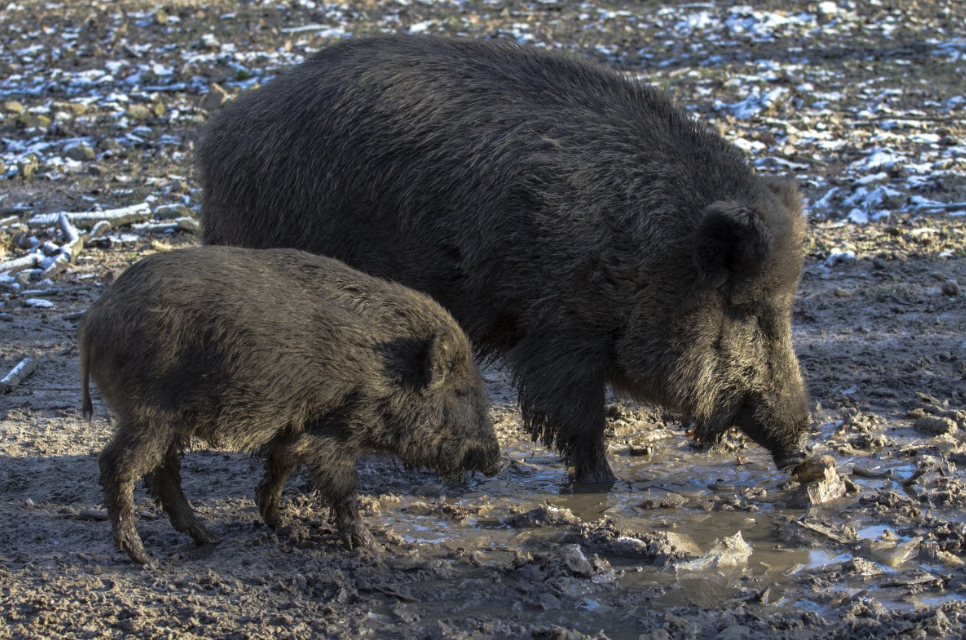Pigs, hogs, and wild boars are similar species in the family Suidae, but there are some important distinctions between them.
Pigs are domesticated animals that have been bred for generations to be docile and provide food for humans, while hogs and wild boars are their wild ancestors.
Though they may look similar, hogs and wild boars are typically much larger and more aggressive than pigs.
Table of Contents
Pigs
Pigs are the smallest of the three species, with an adult male weighing in at around 250 pounds.
They have thick, pink skin that is covered in coarse hair.
Pigs are omnivorous, meaning they will eat both plants and animals.
They are intelligent animals and can be trained to perform tricks or tasks.
Hogs
Hogs are the next size up from pigs, with adult males weighing in at around 400-500 pounds.
They have similar thick, pink skin to pigs, but their hair is shorter and sparser.
Like pigs, hogs are also omnivorous.
However, they are not as intelligent as pigs and cannot be trained to perform tricks or tasks.
Wild Boars
Wild boars are the largest of the three species, with adult males weighing in at around 600-700 pounds.
They have thick, brownish-black skin that is covered in coarse hair.
Wild boars are also omnivorous, but they are not as intelligent as pigs and cannot be trained to perform tricks or tasks.
What’s the difference between pigs, hogs, and wild boars?
While pigs, hogs, and wild boars may look similar, there are some important distinctions between them.
Pigs are domesticated animals that have been bred for generations to be docile and provide food for humans, while hogs and wild boars are their wild ancestors.
Though they may look similar, hogs and wild boars are typically much larger and more aggressive than pigs.
What You Should Know About Wild Boars and Hogs
Pigs, hogs, wild boars – FAQs
What’s the difference between a pig and a hog?
Hogs are wild boars that have been domesticated, while pigs are a specific type of domesticated hog.
Pigs are smaller than hogs, with adult males weighing in at around 250 pounds.
They have thick, pink skin that is covered in coarse hair.
Pigs are omnivorous, meaning they will eat both plants and animals.
They are intelligent animals and can be trained to perform tricks or tasks.
What’s the difference between a hog and a wild boar?
Wild boars are the ancestors of hogs, from which they have been domesticated.
Wild boars are larger than hogs, with adult males weighing in at around 600-700 pounds.
They have thick, brownish-black skin that is covered in coarse hair.
Wild boars are also omnivorous, but they are not as intelligent as pigs and cannot be trained to perform tricks or tasks.
What’s the difference between a pig and a wild boar?
Pigs are domesticated animals that have been bred for generations to be docile and provide food for humans, while wild boars are their wild ancestors.
Though they may look similar, wild boars are typically much larger and more aggressive than pigs.
Pigs are smaller than wild boars, with adult males weighing in at around 250 pounds.
They have thick, pink skin that is covered in coarse hair.
Pigs are omnivorous, meaning they will eat both plants and animals.
They are intelligent animals and can be trained to perform tricks or tasks.
Are hogs and pigs the same thing?
Hogs are wild boars that have been domesticated, while pigs are a specific type of domesticated hog.
Pigs are smaller than hogs, with adult males weighing in at around 250 pounds.
They have thick, pink skin that is covered in coarse hair.
Pigs are omnivorous, meaning they will eat both plants and animals.
They are intelligent animals and can be trained to perform tricks or tasks.
Are wild boars and hogs the same thing?
Wild boars are the ancestors of hogs, from which they have been domesticated.
Though they may look similar, hogs are typically much larger and more aggressive than wild boars.
Wild boars are larger than hogs, with adult males weighing in at around 600-700 pounds.
They have thick, brownish-black skin that is covered in coarse hair.
Wild boars are also omnivorous, but they are not as intelligent as pigs and cannot be trained to perform tricks or tasks.
Do pigs eat other animals?
Pigs are omnivores, which means that they will eat both plants and animals.
Pigs have been known to eat small mammals, reptiles, amphibians, birds, and even other pigs.
In the wild, they typically eat roots, tubers, insects, grubs, and carrion.
Do hogs eat other animals?
Hogs are omnivores, which means that they will eat both plants and animals.
Hogs have been known to eat small mammals, reptiles, amphibians, birds, and even other hogs. In the wild, they typically eat roots, tubers, insects, grubs, and carrion.
Do wild boars eat other animals?
Wild boars are omnivores as well, but they primarily consume plant matter.
In the wild, they typically eat roots, tubers, leaves, fruits, and nuts.
They will also eat small mammals, reptiles, amphibians, birds, and even other wild boars.
What do pigs eat?
Pigs are omnivores, which means that they will eat both plants and animals.
In the wild, they typically eat roots, tubers, insects, grubs, and carrion.
Pigs have also been known to eat small mammals, reptiles, amphibians, birds, and even other pigs.
What do hogs eat?
Hogs are omnivores as well, so they will also eat both plants and animals.
In the wild, they typically eat roots, tubers, insects, grubs, and carrion.
Hogs have also been known to eat small mammals, reptiles, amphibians, birds, and even other hogs.
What do wild boars eat?
Wild boars are primarily herbivores, but they will occasionally eat small mammals, reptiles, amphibians, birds, and other wild boars. In the wild, they typically eat roots, tubers, leaves, fruits, and nuts.


